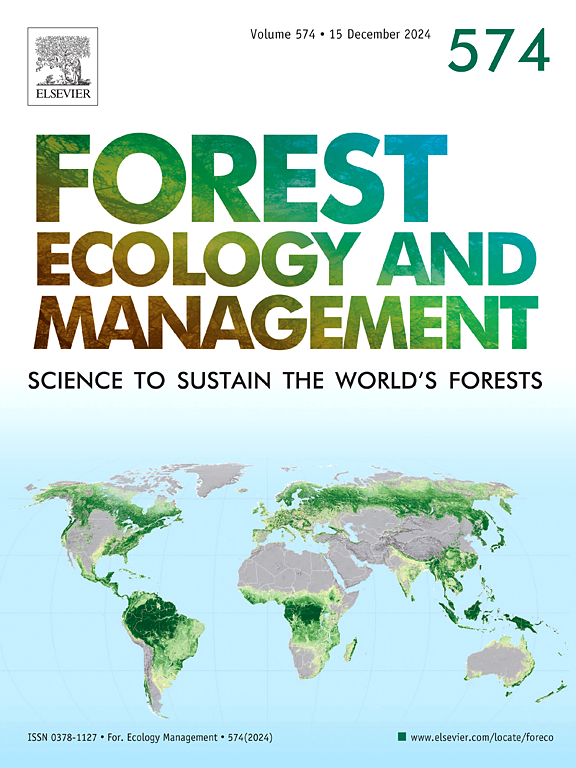Effects of variable retention on the interaction between tree regeneration and understory plants at different regeneration heights over 15 years in Nothofagus pumilio forests
IF 3.7
2区 农林科学
Q1 FORESTRY
引用次数: 0
Abstract
Tree regeneration grows in forests mixed with understory plants, leading to complex interactions that can positively, neutrally, or negatively affect regeneration. This study analyzed the effect of variable retention harvesting on the interaction between understory plants and the tree regeneration at different regeneration heights over 15 years in harvested N. pumilio forests of Tierra del Fuego (Argentina). We evaluated accompanying species, co-occurrence frequency, interaction indices (intensity-INT and importance-IMP) and assemblage patterns of accompanying species in aggregated retention-AR, dispersed retention (influenced-DRI and not influenced-DR by aggregates) and unmanaged primary forest-PF, across 72 permanent plots over 2–18 years after harvesting. Eleven understory species were the most frequent interacting plants, including natives (Osmorhiza depauperata, Galium aparine) and exotics (Poa pratensis, Taraxacum officinale). Co-occurrence was observed in 73 % of samples, varying among treatments (DRI>AR≈DR>PF), with higher frequencies in harvested forests for 0–20 cm height category. INT differed significantly at the community level only for 0–20 cm height category (F=9.78; p < 0.001), with positive values in harvested forests (DRI>DR>AR) and negative in PF. Erect herbs and exotic species had the most negative INT in PF (-0.97, −0.84), while DRI showed positive INT for grasses and erect herbs (INT>0.24). IMP was mostly neutral across treatments. Our results suggested that interaction indices change with regeneration height from positive to negative in harvested areas. Additionally, the assemblage of accompanying species differed even among harvested treatments (PF≠AR≠DRI≈DR). Although light availability and seed production play dominant roles, interactions could be relevant for early regeneration establishment, in harvested forests.
在 15 年的时间里,在不同的再生高度上,可变保留率对 Nothofagus pumilio 森林中树木再生和林下植物之间相互作用的影响
树木在与林下植物混生的森林中再生,会产生复杂的相互作用,对再生产生积极、中性或消极的影响。本研究分析了在火地岛(阿根廷)的 N. pumilio 采伐林中,15 年间不同保留度的采伐对林下植物与不同再生高度的树木再生之间的相互作用的影响。我们评估了采伐后 2-18 年间 72 个永久性地块中的伴生物种、共同出现频率、交互作用指数(强度-INT 和重要性-IMP)以及伴生物种在聚集保留地-AR、分散保留地(受聚集地影响-DRI 和不受聚集地影响-DR)和无管理原始森林-PF 中的组合模式。11 种林下物种是最常见的相互作用植物,包括本地物种(Osmorhiza depauperata、Galium aparine)和外来物种(Poa pratensis、Taraxacum officinale)。在 73% 的样本中观察到了共生现象,不同处理(DRI>AR≈DR>PF)之间存在差异,在高度为 0-20 cm 的采伐林中共生频率较高。只有 0-20 厘米高度类别的 INT 在群落水平上存在明显差异(F=9.78; p <0.001),在采伐林中(DRI>AR≈DR>PF)为正值,在采伐林中为负值。直立草本植物和外来物种在 PF 中的 INT 值最大为负值(-0.97,-0.84),而 DRI 对禾本科植物和直立草本植物的 INT 值为正值(INT>0.24)。在不同处理中,IMP 大多呈中性。我们的研究结果表明,在收割区,交互作用指数会随着再生高度的变化由正变负。此外,即使在不同的收割处理中,伴生物种的组合也存在差异(PF≠AR≠DRI≈DR)。虽然光照和种子生产起着主导作用,但在采伐林中,相互作用可能与早期再生的建立有关。
本文章由计算机程序翻译,如有差异,请以英文原文为准。
求助全文
约1分钟内获得全文
求助全文
来源期刊

Forest Ecology and Management
农林科学-林学
CiteScore
7.50
自引率
10.80%
发文量
665
审稿时长
39 days
期刊介绍:
Forest Ecology and Management publishes scientific articles linking forest ecology with forest management, focusing on the application of biological, ecological and social knowledge to the management and conservation of plantations and natural forests. The scope of the journal includes all forest ecosystems of the world.
A peer-review process ensures the quality and international interest of the manuscripts accepted for publication. The journal encourages communication between scientists in disparate fields who share a common interest in ecology and forest management, bridging the gap between research workers and forest managers.
We encourage submission of papers that will have the strongest interest and value to the Journal''s international readership. Some key features of papers with strong interest include:
1. Clear connections between the ecology and management of forests;
2. Novel ideas or approaches to important challenges in forest ecology and management;
3. Studies that address a population of interest beyond the scale of single research sites, Three key points in the design of forest experiments, Forest Ecology and Management 255 (2008) 2022-2023);
4. Review Articles on timely, important topics. Authors are welcome to contact one of the editors to discuss the suitability of a potential review manuscript.
The Journal encourages proposals for special issues examining important areas of forest ecology and management. Potential guest editors should contact any of the Editors to begin discussions about topics, potential papers, and other details.
 求助内容:
求助内容: 应助结果提醒方式:
应助结果提醒方式:


